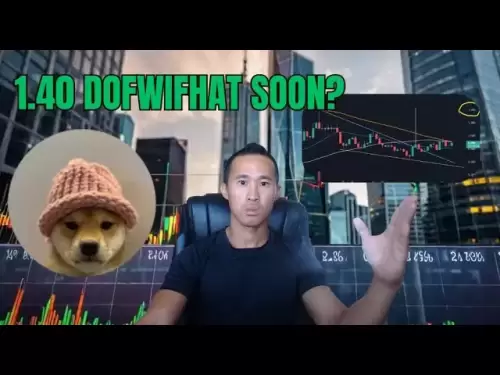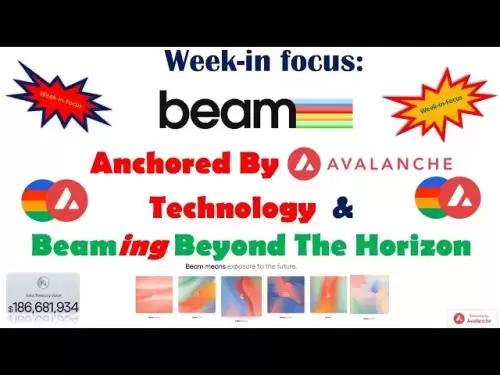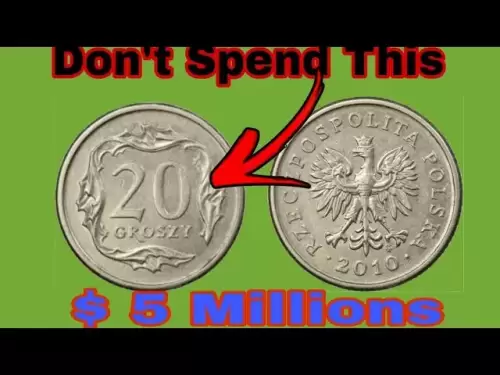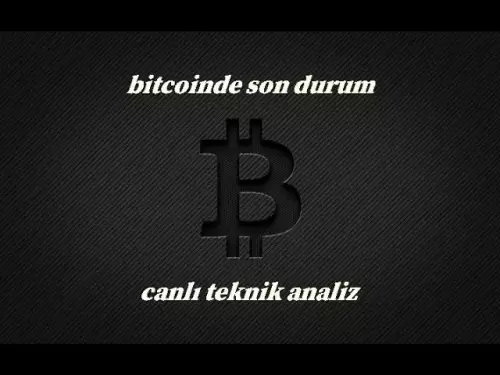-
 Bitcoin
Bitcoin $108,562.4295
0.46% -
 Ethereum
Ethereum $2,533.9553
1.52% -
 Tether USDt
Tether USDt $1.0002
-0.01% -
 XRP
XRP $2.2542
2.23% -
 BNB
BNB $662.4567
1.48% -
 Solana
Solana $151.4114
3.48% -
 USDC
USDC $0.9999
0.00% -
 TRON
TRON $0.2860
0.91% -
 Dogecoin
Dogecoin $0.1685
3.72% -
 Cardano
Cardano $0.5809
1.63% -
 Hyperliquid
Hyperliquid $39.2916
1.85% -
 Sui
Sui $2.8874
0.85% -
 Bitcoin Cash
Bitcoin Cash $496.5801
2.72% -
 Chainlink
Chainlink $13.3582
2.48% -
 UNUS SED LEO
UNUS SED LEO $9.0279
0.07% -
 Avalanche
Avalanche $18.0773
2.30% -
 Stellar
Stellar $0.2426
3.05% -
 Toncoin
Toncoin $2.9086
6.01% -
 Shiba Inu
Shiba Inu $0.0...01170
2.97% -
 Hedera
Hedera $0.1587
3.47% -
 Litecoin
Litecoin $87.4596
1.13% -
 Monero
Monero $317.0425
0.73% -
 Polkadot
Polkadot $3.3778
1.90% -
 Dai
Dai $0.9999
-0.01% -
 Ethena USDe
Ethena USDe $1.0001
-0.01% -
 Bitget Token
Bitget Token $4.4095
0.63% -
 Uniswap
Uniswap $7.3593
6.80% -
 Pepe
Pepe $0.0...09910
3.64% -
 Aave
Aave $274.7388
2.68% -
 Pi
Pi $0.4607
0.48%
Should UNI sell immediately after the MACD cross appears?
Selling UNI after a MACD cross requires considering market trends, other indicators like RSI, and personal risk tolerance, not just the MACD signal alone.
Apr 26, 2025 at 04:28 am
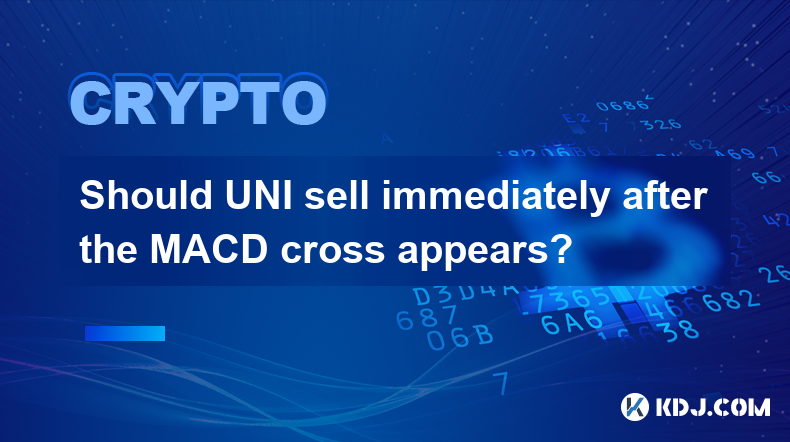
The decision to sell UNI, the native token of the Uniswap decentralized exchange, immediately after a MACD (Moving Average Convergence Divergence) cross appears is a nuanced one that requires a deeper understanding of both technical analysis and the broader market context. The MACD is a popular momentum indicator used by traders to identify potential buy or sell signals in the market. A MACD cross, where the MACD line crosses above or below the signal line, is often considered a significant event that could indicate a change in market momentum. However, whether or not to sell UNI immediately after such an event depends on various factors, including the overall trend, other technical indicators, and the trader's personal strategy and risk tolerance.
Understanding the MACD Indicator
The MACD is calculated by subtracting the 26-period Exponential Moving Average (EMA) from the 12-period EMA. The result of this calculation is the MACD line. A 9-period EMA of the MACD line is then plotted as the signal line. When the MACD line crosses above the signal line, it is considered a bullish signal, suggesting that it might be a good time to buy. Conversely, when the MACD line crosses below the signal line, it is considered a bearish signal, which might indicate a good time to sell.
The MACD indicator alone does not provide a complete picture of the market. It is essential to consider the broader market context and other technical indicators to make a more informed decision.
The Importance of Market Context
Before deciding to sell UNI based on a MACD cross, it is crucial to assess the overall market trend. If the market is in a strong bullish trend, a single bearish MACD cross might not be a sufficient reason to sell. Conversely, if the market is showing signs of a bearish reversal, a bearish MACD cross could be a more compelling signal to sell.
Analyzing the market context involves looking at other indicators such as the Relative Strength Index (RSI), Bollinger Bands, and volume. For instance, if the RSI is also showing overbought conditions and the volume is decreasing, these factors together might strengthen the case for selling UNI after a bearish MACD cross.
Additional Technical Indicators
While the MACD cross is a useful signal, relying solely on it can lead to premature selling or buying. Combining the MACD with other technical indicators can provide a more robust trading strategy. For example, if the MACD cross occurs near a key support or resistance level, it might be more significant. Additionally, if the MACD histogram, which represents the difference between the MACD line and the signal line, is also showing a divergence from the price, this could further validate the signal.
Risk Management and Trading Strategy
Every trader has a different risk tolerance and trading strategy. Some traders might use the MACD cross as a strict rule to enter or exit positions, while others might use it as one of many factors in their decision-making process. For instance, a conservative trader might wait for additional confirmation from other indicators before selling, whereas a more aggressive trader might sell immediately after a bearish MACD cross.
Risk management is also crucial. Setting stop-loss orders can help mitigate potential losses if the market moves against the trader's position. For example, if a trader decides to sell UNI after a bearish MACD cross, they might set a stop-loss order just above the recent high to limit their potential loss if the price rebounds.
Practical Example of Using MACD to Sell UNI
Let's consider a practical example of how a trader might use the MACD to decide whether to sell UNI. Suppose the MACD line has just crossed below the signal line, indicating a potential bearish trend. Here are the steps a trader might take:
- Check the overall market trend: Look at the broader cryptocurrency market to see if other major cryptocurrencies are also showing bearish signs.
- Analyze other technical indicators: Check the RSI to see if it is in overbought territory, and examine the volume to see if it is decreasing.
- Identify key support and resistance levels: If the MACD cross occurs near a significant resistance level, it might be a more compelling signal to sell.
- Consider the MACD histogram: If the histogram is also showing a bearish divergence from the price, this could further validate the sell signal.
- Set a stop-loss order: If the trader decides to sell, they might set a stop-loss order just above the recent high to limit potential losses.
Conclusion
Deciding whether to sell UNI immediately after a MACD cross involves more than just following a single indicator. It requires a comprehensive analysis of the market context, other technical indicators, and the trader's personal risk management strategy. While a bearish MACD cross can be a useful signal, it should be considered alongside other factors to make a more informed trading decision.
Frequently Asked Questions
Q: How can I use the MACD to identify potential entry points for UNI?
A: To identify potential entry points for UNI using the MACD, look for a bullish MACD cross where the MACD line crosses above the signal line. Additionally, consider the overall market trend and other technical indicators such as the RSI and volume to confirm the signal. For example, if the RSI is in oversold territory and the volume is increasing, this could strengthen the case for entering a long position on UNI.
Q: Can the MACD be used effectively in a highly volatile market like cryptocurrencies?
A: Yes, the MACD can be used effectively in a highly volatile market like cryptocurrencies, but it should be combined with other indicators and risk management strategies. Volatility can lead to false signals, so it's important to use the MACD in conjunction with other tools to filter out noise and confirm trends.
Q: What are some common mistakes traders make when using the MACD to trade UNI?
A: Some common mistakes traders make when using the MACD to trade UNI include relying solely on the MACD without considering other indicators, not adjusting the MACD settings to suit the volatility of the cryptocurrency market, and not using proper risk management techniques such as stop-loss orders. It's crucial to use the MACD as part of a broader trading strategy to avoid these pitfalls.
Q: How can I adjust the MACD settings for trading UNI more effectively?
A: To adjust the MACD settings for trading UNI more effectively, you might consider shortening the periods used in the calculation to better capture the rapid price movements typical in the cryptocurrency market. For example, instead of using the standard 12, 26, and 9 periods, you might experiment with shorter periods like 5, 10, and 3 to generate more timely signals. However, be aware that shorter periods can also lead to more false signals, so it's important to test and validate any changes to the settings.
Disclaimer:info@kdj.com
The information provided is not trading advice. kdj.com does not assume any responsibility for any investments made based on the information provided in this article. Cryptocurrencies are highly volatile and it is highly recommended that you invest with caution after thorough research!
If you believe that the content used on this website infringes your copyright, please contact us immediately (info@kdj.com) and we will delete it promptly.
- BNB, Binance, and CZ: What's the Buzz?
- 2025-07-07 06:50:12
- Hedera Hashgraph: ETF Buzz and Bullish Charts – HBAR to the Moon?
- 2025-07-07 06:30:12
- BlockDAG, Pi Network, and SUI Stable: Navigating the Crypto Landscape in '25
- 2025-07-07 07:10:13
- SYRUP Token's Sweet Ascent: TVL Surges and DeFi Growth on Maple Finance
- 2025-07-07 07:15:13
- Bitcoin, Listed Companies, and ETFs: A New York Minute on Crypto Trends
- 2025-07-07 06:30:12
- Stablecoins, Redot Pay, and Korea: A Glimpse into the Future of Payments
- 2025-07-07 07:20:14
Related knowledge
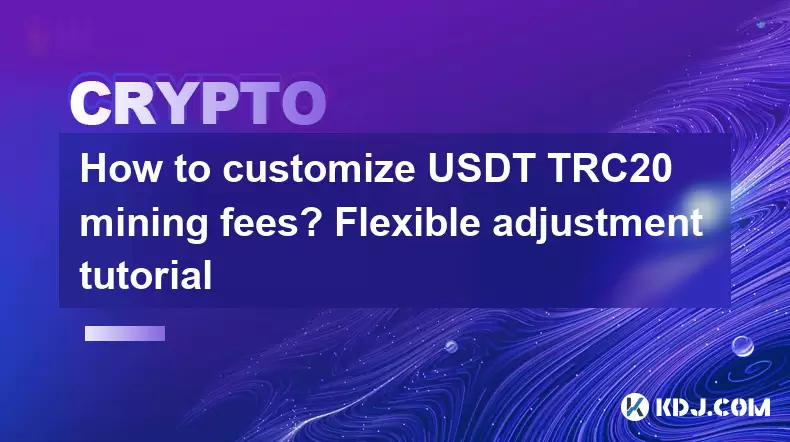
How to customize USDT TRC20 mining fees? Flexible adjustment tutorial
Jun 13,2025 at 01:42am
Understanding USDT TRC20 Mining FeesMining fees on the TRON (TRC20) network are essential for processing transactions. Unlike Bitcoin or Ethereum, where miners directly validate transactions, TRON uses a delegated proof-of-stake (DPoS) mechanism. However, users still need to pay bandwidth and energy fees, which are collectively referred to as 'mining fe...
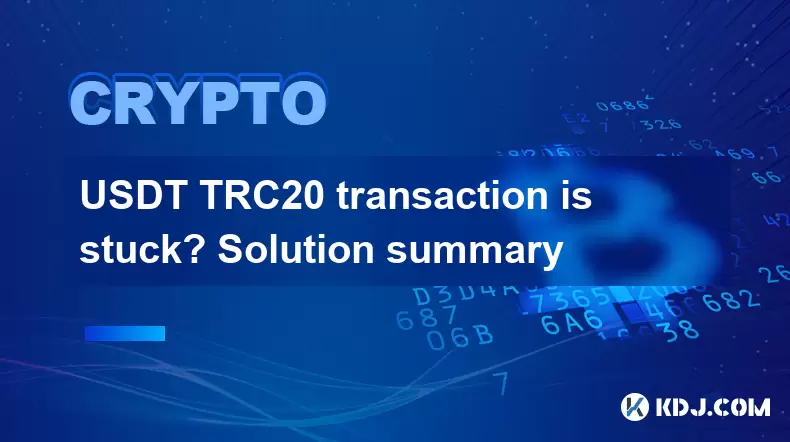
USDT TRC20 transaction is stuck? Solution summary
Jun 14,2025 at 11:15pm
Understanding USDT TRC20 TransactionsWhen users mention that a USDT TRC20 transaction is stuck, they typically refer to a situation where the transfer of Tether (USDT) on the TRON blockchain has not been confirmed for an extended period. This issue may arise due to various reasons such as network congestion, insufficient transaction fees, or wallet-rela...
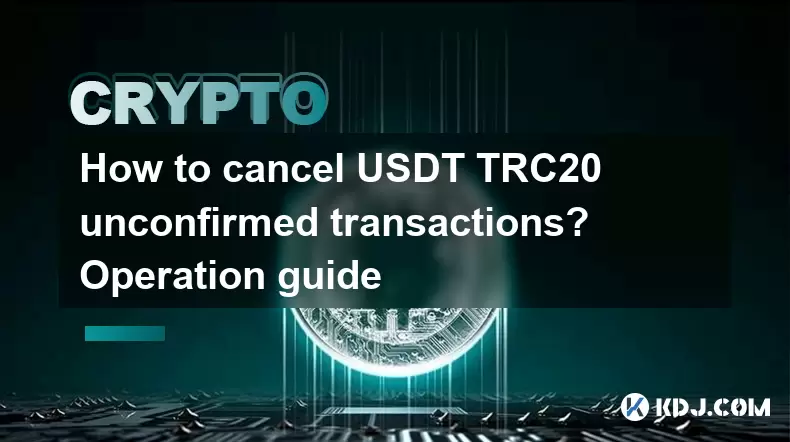
How to cancel USDT TRC20 unconfirmed transactions? Operation guide
Jun 13,2025 at 11:01pm
Understanding USDT TRC20 Unconfirmed TransactionsWhen dealing with USDT TRC20 transactions, it’s crucial to understand what an unconfirmed transaction means. An unconfirmed transaction is one that has been broadcasted to the blockchain network but hasn’t yet been included in a block. This typically occurs due to low transaction fees or network congestio...
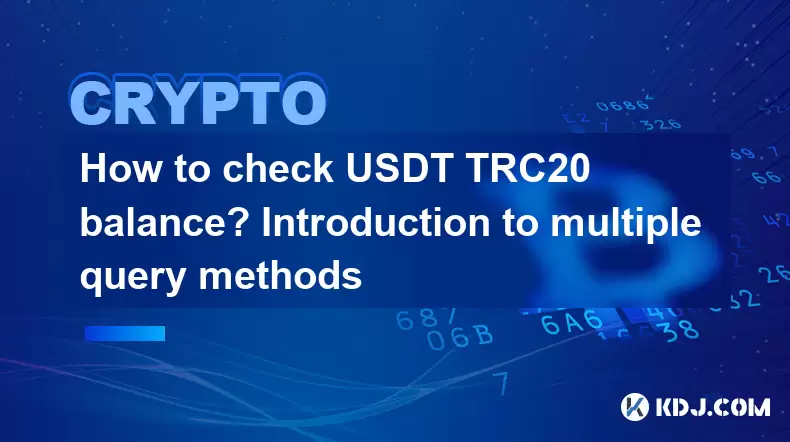
How to check USDT TRC20 balance? Introduction to multiple query methods
Jun 21,2025 at 02:42am
Understanding USDT TRC20 and Its ImportanceUSDT (Tether) is one of the most widely used stablecoins in the cryptocurrency market. It exists on multiple blockchain networks, including TRC20, which operates on the Tron (TRX) network. Checking your USDT TRC20 balance accurately is crucial for users who hold or transact with this asset. Whether you're sendi...
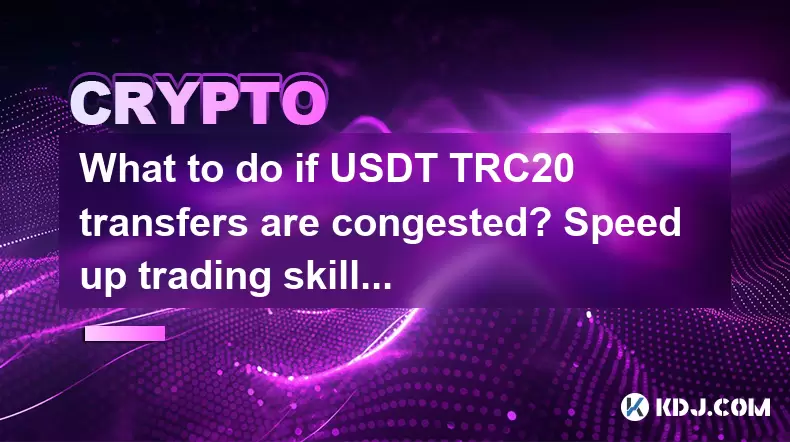
What to do if USDT TRC20 transfers are congested? Speed up trading skills
Jun 13,2025 at 09:56am
Understanding USDT TRC20 Transfer CongestionWhen transferring USDT TRC20, users may occasionally experience delays or congestion. This typically occurs due to network overload on the TRON blockchain, which hosts the TRC20 version of Tether. Unlike the ERC20 variant (which runs on Ethereum), TRC20 transactions are generally faster and cheaper, but during...
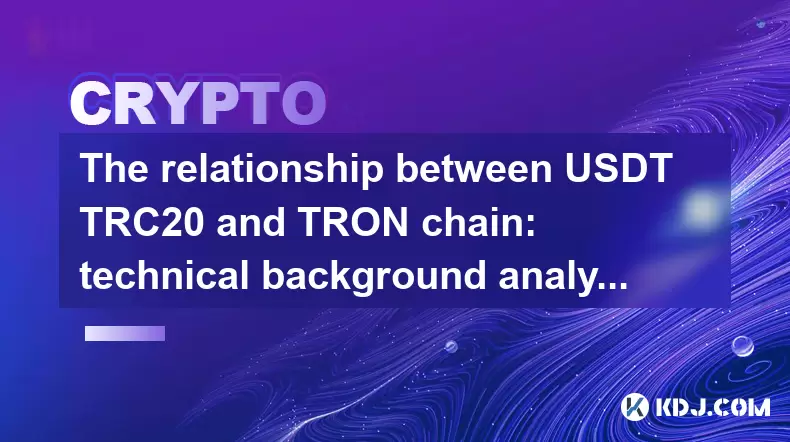
The relationship between USDT TRC20 and TRON chain: technical background analysis
Jun 12,2025 at 01:28pm
What is USDT TRC20?USDT TRC20 refers to the Tether (USDT) token issued on the TRON blockchain using the TRC-20 standard. Unlike the more commonly known ERC-20 version of USDT (which runs on Ethereum), the TRC-20 variant leverages the TRON network's infrastructure for faster and cheaper transactions. The emergence of this version came as part of Tether’s...

How to customize USDT TRC20 mining fees? Flexible adjustment tutorial
Jun 13,2025 at 01:42am
Understanding USDT TRC20 Mining FeesMining fees on the TRON (TRC20) network are essential for processing transactions. Unlike Bitcoin or Ethereum, where miners directly validate transactions, TRON uses a delegated proof-of-stake (DPoS) mechanism. However, users still need to pay bandwidth and energy fees, which are collectively referred to as 'mining fe...

USDT TRC20 transaction is stuck? Solution summary
Jun 14,2025 at 11:15pm
Understanding USDT TRC20 TransactionsWhen users mention that a USDT TRC20 transaction is stuck, they typically refer to a situation where the transfer of Tether (USDT) on the TRON blockchain has not been confirmed for an extended period. This issue may arise due to various reasons such as network congestion, insufficient transaction fees, or wallet-rela...

How to cancel USDT TRC20 unconfirmed transactions? Operation guide
Jun 13,2025 at 11:01pm
Understanding USDT TRC20 Unconfirmed TransactionsWhen dealing with USDT TRC20 transactions, it’s crucial to understand what an unconfirmed transaction means. An unconfirmed transaction is one that has been broadcasted to the blockchain network but hasn’t yet been included in a block. This typically occurs due to low transaction fees or network congestio...

How to check USDT TRC20 balance? Introduction to multiple query methods
Jun 21,2025 at 02:42am
Understanding USDT TRC20 and Its ImportanceUSDT (Tether) is one of the most widely used stablecoins in the cryptocurrency market. It exists on multiple blockchain networks, including TRC20, which operates on the Tron (TRX) network. Checking your USDT TRC20 balance accurately is crucial for users who hold or transact with this asset. Whether you're sendi...

What to do if USDT TRC20 transfers are congested? Speed up trading skills
Jun 13,2025 at 09:56am
Understanding USDT TRC20 Transfer CongestionWhen transferring USDT TRC20, users may occasionally experience delays or congestion. This typically occurs due to network overload on the TRON blockchain, which hosts the TRC20 version of Tether. Unlike the ERC20 variant (which runs on Ethereum), TRC20 transactions are generally faster and cheaper, but during...

The relationship between USDT TRC20 and TRON chain: technical background analysis
Jun 12,2025 at 01:28pm
What is USDT TRC20?USDT TRC20 refers to the Tether (USDT) token issued on the TRON blockchain using the TRC-20 standard. Unlike the more commonly known ERC-20 version of USDT (which runs on Ethereum), the TRC-20 variant leverages the TRON network's infrastructure for faster and cheaper transactions. The emergence of this version came as part of Tether’s...
See all articles





















